Address any questions or comments regarding this newsletter to the individual authors listed after each article or to its editors, Nathan Johanning, 618-939-3434, njohann@illinois.edu or Bronwyn Aly 618-695-6060, baly@illinois.edu. The Illinois Fruit and Vegetable News is available on the web at: http://ipm.illinois.edu/ifvn/. To receive or be removed from email notification of new postings of this newsletter, contact Nathan Johanning or Bronwyn Aly at the phone numbers or email addresses above.
In This Issue:
Upcoming Programs (listings for beginning and established growers)
News & Announcements (Fruit & Vegetable Research Priorities Survey, Value Added Producer Grant)
Regional Reports (St. Louis Metro-east, east central, southern Illinois)
Fruit and Vegetable Production and Pest Management (FSMA Produce Rule Compliance Dates, Yellow Leaves on Pumpkins, Vole Management)
Upcoming Programs
Check the Illinois SARE calendar for a full list of programs and links for registration.
http://illinoissare.org/ and http://illinoissare.org/calendar.php
Also see the University of Illinois Extension Local Food Systems and Small Farms Team's website at:
http://web.extension.illinois.edu/smallfarm/ and the calendar of events at http://web.extension.illinois.edu/units/calendar.cfm?UnitID=629.
- Midwest Mechanical Weed Control Field Day, Tuesday, September 26, 2017, 10 a.m.- 5 p.m. Michigan State University Horticulture Farm, 3291 College Rd, Holt, MI. From finger weeders to flex-tines to Allis G's and beyond, come learn the principles and tools for precise mechanical weed control from farmers and researchers. New weeding machines are recently available from Europe and many types and models of mechanical weeders will be on display and demonstrated in the field. You will hear from farmers using these tools, learn about cultivation techniques in Europe, see tools demonstrated, and enjoy lunch and time to speak with all the growers in attendance. Register online at Midwest Mechanical Weed Control Field Day, or contact Sam Hitchcock Tilton at 414-213-5337 or hitchc32@msu.edu
- Produce Safety Alliance Grower Training Course, Monday, November 13, 2017, 8 a.m.- 5p.m. CST. University of Illinois Extension led training will be held at Rend Lake College – Applied Science Center, Room 102, 468 N. Ken Gray Parkway, Ina, Illinois 62846. Registration fee of $120 includes PSA training manual, AFDO certificate, and lunch. Visit the following link for more information or to register for the training https://web.extension.illinois.edu/registration/?RegistrationID=17068 or contact Laurie George at (618) 242-0780 or ljgeorge@illinois.edu
- 2018 Illinois Specialty Crops, Agritourism, & Organics Conference, Wednesday-Friday, January 10-12, 2018. Crowne Plaza Hotel, Springfield, IL. Save the date; more details closer to event. For more information visit the ISGA website.
- 2018 Gateway Small Fruit & Vegetable Conference, Wednesday, February 7, 2018. Regency Conference Center, O'Fallon, IL. Save the date; more details closer to the event. For more information contact Elizabeth Wahle at wahle@illinois.edu or 618-344-4230.
- 2018 Southern & Southwestern Illinois Commercial Tree Fruit Schools, Tuesday & Wednesday, February 13 & 14, 2018. Mt. Vernon & Hardin, IL. Save the date; more details closer to event. For more information contact Laurie George at (618) 242-0780 or lgeorge@illinois.edu
News & Announcements
REMINDER: Please Remember to Fill Out the Fruit and Vegetable Research Priorities Survey
This survey was compiled by Elizabeth Wahle, Nathan Johanning, and Bronwyn Aly with the purpose of accessing the research needs on vegetable, high tunnel, and fruit production in Illinois. By prioritizing and focusing on specific areas identified by specialty crops growers and industry professionals, the University of Illinois can work with the industry to target those research needs. This survey is not intended to be a list of crops you are currently growing, but rather, a mechanism to provide direction to future research endeavors. Your input will directly influence the direction of future applied specialty crop research! Please take 5 minutes to fill out the survey by clicking on the following link: Fruit and Vegetable Research Priorities or via the paper copy enclosed in the newsletter. If you have specific comments or thoughts regarding research focus areas not addressed by the survey, please feel free to contact Elizabeth, Nathan, or Bronwyn at your convenience (see the contact list at the end). Thank you for your feedback and thank you to those that have already submitted a survey!
Bronwyn Aly (618-382-2662; baly@illinois.edu)
2017 USDA Value Added Producer Grant
USDA published a Notice in the 8/29/17 Federal Register inviting VAPG applications for fiscal year 2017. Approximately $18 million is available for this nationally competitive program. Please note that as further described in the Notice, additional funding may be added to this application cycle should fiscal year 2018 VAPG funding become available. Should that happen, there wouldn't likely be a separate fiscal year 2018 application cycle.
The deadline for submitting VAPG applications is January 31, 2018 for paper applications or January 24, 2018 for applications submitted via www.grants.gov. Applications may be mailed, submitted online via www.grants.gov, or delivered to the USDA Rural Development State Office in Champaign by hand. Emailed and faxed applications will not be accepted. Applications and information submitted after the application deadline will not be considered.
To assist you in preparing your application, our National Office has developed application packages for planning and working capital grants that can be downloaded from the main VAPG website shown below. These "application toolkits" have been revised since last year, so please be sure to use the 2017 versions (which should be available on the website by the end of the day). Please note the use of this application package/template is not required, but is highly recommended. This website also has general VAPG program information sheets available as well as information sheets for specific types of projects. I have also attached a "VAPG Fact Sheet" that we've developed in IL that contains a lot of useful general program information. Please note that these information/fact sheets should not be read in lieu of the Federal Register Notice and VAPG regulation (RD Instruction 4284-J). These documents are meant to be quick references with basic program information, thus they should not be your only source of VAPG information.
VAPG Fact Sheet
PROGRAM PURPOSE – The VAPG Program provides grant funds to agricultural producers for planning activities or working capital expenses to help them enter into value-added activities related to the processing or marketing of bio-based value-added products.
WHO'S ELIGIBLE – Applicants must qualify as one of the following in order to be an eligible applicant:
- Independent Producer - Individuals or entities (including profit, NFP, LLCs, partnerships, or LLPs) where the entities are solely owned or controlled by agricultural producers or agricultural harvesters.
- Farmer or Rancher Cooperative – A business owned and controlled by independent producers that is incorporated as a cooperatively operated business. The majority of ownership and financial control must be held by independent producers.
- Agricultural Producer Group – An organization that represents independent producers, whose mission includes working on behalf of the independent producers and the majority of whose membership and board of directors are comprised of independent producers. Examples include general farm organizations such as the Farm Bureau, Illinois Soybean Association, IL Beef Association, and IL Corn Growers Association.
- Majority-Controlled Producer-Based Business Venture – Entities (other than cooperatives) where a majority of the financial ownership and voting rights reside with independent producers who own and produce more than 50% of the raw commodity that will be used in the value-added venture.
VALUE-ADDED CATAGORIES: Value must be added to the raw agricultural commodity in one of the following ways:
- A change in physical state of the commodity (e.g. milk to cheese, grapes to wine). Only eligible if the commodity cannot be returned to its original state after the physical change.
- Produced in a manner than enhances the value of the commodity when compared to standard production methods (e.g. organic vegetables, antibiotic free pork).
- Physical product segregation – Separation of a commodity produced from other varieties of the same commodity produced on the same farm. Separation must be present during production, harvesting, processing, and marketing and must justify an increased value of the commodity (e.g. non-genetically modified corn and genetically modified corn grown on the same farm, but separated by a distance or a structure so that no cross-pollination occurs)
- Farm-based renewable energy – A farm commodity used to produce renewable energy (e.g. corn to ethanol).
- Production or marketing of locally-grown agriculture food products. Locally grown is defined as products being marketed within 400 miles of where they were grown or within the state borders of where they were grown.
USES OF FUNDS: Funds can either be used for planning purposes or working capital expenses. Applicants may apply for one or the other, but not both in the same year. Eligible planning expenses include hiring a qualified consultant to create a business plan, feasibility study, or marketing plan. Eligible working capital expenses include post-harvest labor, inventory, office & processing supplies, facility rent, utilities, marketing expenses, consulting fees, etc. All expenses must relate directly to the value-added process.
INELIGIBLE USES OF FUNDS: VAPG funds cannot be used for any of the following purposes:
- Plan, repair, rehabilitate, acquire, or construct a building or facility including a processing facility
- Purchase, lease purchase/rent-to-own, or install equipment, vehicles or land
- Pay any expenses not directly related to the value added venture
- Pay any expenses related to the production or harvesting of the raw agricultural commodity to which the value will be added
- Research and development
- Pay wages to or purchase goods/services from an owner or immediate family member of an owner of the venture
OTHER REQUIREMENTS:
- Grant funds must be matched dollar for dollar by the applicant. Matching funds can be in the form of cash, line of credit, or in-kind contributions. Cash contributions cannot include other federal grant funds. Matching funds must be spent on eligible planning or working capital expenses.
- Except for independent producers, applicants must prove that they are entering an emerging market. An emerging market is a new or developing geographic or demographic market that is new to the applicant or the applicant's value-added product. The applicant cannot have supplied the value-added product to the new market for more than two years at the time of application submission.
- Independent producers who are part of the applicant organization must produce at least 51% of the raw commodity that is used in the value-added process, and they must be producing an equivalent amount at the time of application submission.
- Independent producers must own the commodity from its raw, unprocessed state through the value-added procedures (certain exceptions apply for mid-tier value chain projects).
- Working capital applications of $50,000 or more must already have a business plan and feasibility study completed that meet the requirements of the Agency (certain exceptions apply for Independent Producers).
- Maximum planning grant award is $75,000. Maximum working capital grant award is $250,000. These limits may change periodically depending on appropriations.
CONTACTS: For more information about this program, visit www.rd.usda.gov/programs-services/value-added-producer-grants or contact any of the following:
Matt Harris |
Ron Firkins |
Below are helpful websites for this program including websites that can be visited to find the Federal Register publication and VAPG Program Regulation. A PDF version of the NOFA is attached for your convenience.
http://www.rd.usda.gov/programs-services/value-added-producer-grants - This is the main VAPG website.
https://www.gpo.gov/fdsys/pkg/FR-2017-08-29/pdf/2017-18306.pdf?utm_campaign=subscription%20mailing%20list&utm_source=federalregister.gov&utm_medium=email - This is a link to the 2017 VAPG Federal Register Publication (PDF version attached to this email also).
http://www.rd.usda.gov/files/4284j.pdf - This is a link to the VAPG program's regulation – 4284-J (PDF version attached to this email also).
If you have questions, please feel free to contact Matt Harris at matthew.harris@il.usda.gov
Regional Reports
From Northern Illinois... The last week has seen cooler than average temperatures in the area. Evening temperatures have been in the 50s F with days in high 70s. We've had a period of spotty rainfall. There has been a delay in ripening of tomatoes and peppers because of these temperatures. This week, evening temperatures will reach low in the 40s.
Growers in Northern Illinois are reminded to plan and plant now the cover crops available to them. Some of these need warm soil temperatures to germinate properly. With the average first frost a month away in some counties, each week closer to that date removes available cover crops that can put on enough growth. A key piece of advice I am always reminded of comes from Dr. Ajay Nair of Iowa State who has said to consider the Exit Strategy even before planting. How will you kill and remove it? Tilled under? Winter Kill? Herbicide? Cut? Crimped? Know how the cover crop will be killed as you think about which one to grow.
We have wrapped up our Late Summer Field Days in Jo Daviess/Stephenson/Winnebago Counties. These field days are for backyard growers and commercial growers to visit an operation in our area to see what they are growing and how they are marketing their product. In Lena, IL, (Stephenson County), Penny and Nate Peterson at Wishful Acres Farm and Brewery hosted our group. They have a CSA and an on-farm brewery which is unique for the Midwest. The following week in Jo Daviess County, Drew Groezinger at Groezinger Produce Farm, was our 2nd field day. Drew runs at CSA and sells at the Galena Territory Farmers Market. He is further expanding his operation into cut flower production. For more information on these field days, I wrote a recap available on my blog.
Grant McCarty (815-235-4125; gmccarty@illinois.edu)
From the St. Louis Metro-East...Temperatures have been all over the board, from slightly below average to sweltering hot. The most recent sweltering hot was broken up by a much needed drink of water late Labor Day evening. I saw the first corn field combined this past Saturday which will become a more common sight in the next 2-3 weeks. In terms of apples, Gala harvest is finished and Early Fuji, Ruby Jon, and Golden Delicious are being harvested now. Cider making got stared about a week ago. Flame Prince and Autumn Star peaches finished up last week, so for the most part peach harvest is finished. Vignoles grapes have been harvested and cultivars like Vidal blanc and Chardonel are up next.
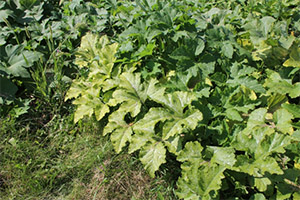
Temporary yellowing of pumpkin leaves
as a result of Quintec application.
Leading up to harvest, pumpkins and winter squash are coloring and sizing nicely. In recent pumpkin field days around the state I have picked up several tips from Mohammad Babadoost, UI State Extension Pathologist that should be of importance to growers. If powdery mildew is present, even if it looks like it covers the entire top surface of the leaves, it is not too late to maintain some level of control. Dr. Babadoost recommends Quintec at this stage, and to not worry about any temporary yellowing of the leaves that it may cause. The plants will grow out of it and not affect fruit ripening. It should be noted that there is a relatively new bacterial disease, named cucurbit yellow vine decline which also causes leaf yellowing. The disease is vectored by the squash bug and causes the eventual collapse of the vine. To date, it has not been detected in Illinois, but growers are advised to be on the lookout. Contact your local Extension office or submit suspected samples to the UI Plant Clinic http://web.extension.illinois.edu/plantclinic/ for positive identification.

Phytophthora Infected Pumpkin Fruit.
Like bacterial wilt, effective control of yellow vine decline is completely dependent on early management of the vector, in this case the squash bug. Kentucky is among other Midwestern states to confirm the presence of yellow vine decline and as such has developed a fact sheet on the subject, including management options http://plantpathology.ca.uky.edu/files/ppfs-vg-12.pdf. One final reminder going into harvest in terms of disease management is the handling of cucurbit fruits infected with Phytophthora. Keeping in mind that one infected fruit co-mingled with healthy fruit can ruin the entire lot, avoid any activity that allows for cross contamination with healthy fruit. For example, after handling a Phytophthora-infected fruit, hands must be washed before handling healthy fruit. The same with foot coverings. If contact is made with an infected vine or fruit while walking a pumpkin field, it is advised to sanitize foot coverings before entering uninfected area.
Elizabeth Wahle (618-344-4230; wahle@illinois.edu)
 From east-central Illinois...The vegetable season is winding down in this area and local farmers are saying that they are not expecting an extended season like last year due to the very dry weather across a good portion of this area. This dry weather has affected the late season sweet corn with some plantings being abandoned. In addition if farmers did not keep up with their pest management and spray schedules, they are reporting heavy disease and insect damage in their squash and pumpkins.
From east-central Illinois...The vegetable season is winding down in this area and local farmers are saying that they are not expecting an extended season like last year due to the very dry weather across a good portion of this area. This dry weather has affected the late season sweet corn with some plantings being abandoned. In addition if farmers did not keep up with their pest management and spray schedules, they are reporting heavy disease and insect damage in their squash and pumpkins.
Doug Gucker (217-877-6042; dgucker@illinois.edu)
From southern Illinois... We continue to have overall cooler than normal temperatures. For the most part, highs have been in the 70s to low 80s. We have had a few scattered days in the 90s like Labor Day. A cold front came through late on Labor Day bringing some rain, but at my office in Murphysboro, only 0.1" which didn't go very far. The front has also brought us the coldest night time temperatures we have seen since spring, with lows this past Wednesday morning (9/6) of 45°. Overall it is VERY dry in most of southern Illinois. The tenth we got this week is the only rainfall we have had in Murphysboro since before the last newsletter. Only the very far southeastern edge of Illinois received any rain from the remnants of hurricane Harvey. At the Ewing Demonstration Center in Franklin County we have only had 1.52" of rain to date since August 1. So far the forecast does not hold any significant rain chances until possibly next week, but even then it not the greatest chance.
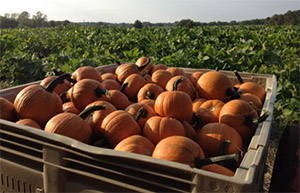
First pumpkin harvest; ‘Touch of Autumn’
pie pumpkins. Photo: N Johanning.
Out in the orchard, we are nearing the end of peaches with some orchards already done with peaches for a few weeks and others down to just the latest varieties. Apples are in full swing and the cool nights have really gotten them coloring up. Jonathans are mostly done and harvest of golden delicious is underway now. Plasticulture strawberry plugs are going in the ground as we speak. Right now our blueberries and brambles are working to set fruit buds for next year so with the dry weather make sure to keep them watered as stress now can greatly impact their yield and productivity next spring.
Out in the vegetable field, we are now into the pumpkin harvest season. Many of the jack o' lantern varieties are ripening and some gourds. Many of the specialty types are a little later, just now starting to get ripe. Compared with some years, pumpkins have been slower to ripen in the last few weeks with many days of coolers than normal temperatures and especially the nights in the 50s and upper 40s. Even now, early in harvest, it is still critical to manage powdery mildew as it still can develop and spread especially to pumpkins stems and greatly reduce pumpkin quality and reduce the growth of any later fruit set. No downy mildew has been confirmed in Illinois on cucurbits; however, it has been confirmed in northwestern Indiana (pumpkins) and also southwestern Indiana (cucumbers & butternut squash). For more information on this Indiana report visit https://vegcropshotline.org/article/downy-mildew-of-cucurbits/ to see a recent newsletter article from Purdue Plant Pathologist, Dan Egel. For more information on disease management in pumpkins refer to the 2017 Midwest Vegetable Production Guide or the 2017 Pumpkin Fungicide Recommendations from Dr. Babadoost.
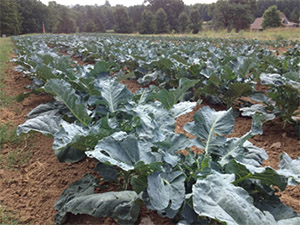
Fall Broccoli growth southern Illinois.
Photo: N Johanning.
Many of our early and mid-season plantings of summer vegetables are nearing the end of their productive life. Fall crops such as broccoli and other cole crops are enjoying this mild, late summer weather. We have fall broccoli which the earliest is just starting to form heads. Remember that as heads are forming, this is a critical time to keep on top of managing the various caterpillar pests that are especially bad in fall production. If these pests persist often later it can be a challenge to get spray coverage on them if they are up inside a tightly formed head.
We just collected data on the second year of our Ornamental Corn Variety Trial in southern Illinois this year planted at the Jackson County Extension Office in Murphysboro. This year's initial results were similar to last year. Just as a sneak peek below is a picture of two of our top performers from the last two years: 'Autumn Splendor' & 'Indian Art #104'. For more details on the trial visit IFVN Issue 22:20 for last year's report or come to the Pumpkin Preconference Workshop at the 2018 Illinois Specialty Crops, Agritourism & Organic Conference this January in Springfield, IL. We will also be sharing more results in future IFVN issues. Thanks to Johnny's Selected Seeds, Rupp Seeds, Rispens and Seedway for their seed donations
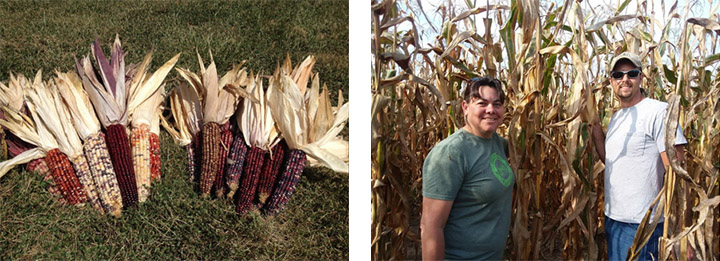
Left Photo: Autumn Splendor (left) and Indian Art #104 from the Ornamental Corn Variety Trial. Photo: N Johanning. Right Photo: IFVN Editors, Bronwyn Aly & Nathan Johanning collecting data on the Ornamental Corn Variety Trial. Photo: L. Heins.
Nathan Johanning (618-939-3434; njohann@illinois.edu)
Fruit and Vegetable Production and Pest Management
FSMA Produce Rule Compliance Dates
The Food Safety Modernization Act Produce Rule became a law on January 26, 2016. It is the first ever mandatory federal standard for growing, harvesting, packing, and holding of fresh produce. In the law, it requires that farms that fall under the Produce Rule become compliant with the new regulations by certain dates. These dates are based on the total amount of food sales for your farm, over a three-year period:
- Exempt farms – Farms that have an average annual value of produce sold during the previous 3-year period less than $25,000 are excluded
HOWEVER, the rule requires documentation to support the exemption - Very small business – the average annual monetary value of produce sold during the previous 3-year period is between $25,000 and $250,000 – must complete training by 1/26/2020.
- Small business – the average annual monetary value of produce sold during the previous 3-year period is no more than $500,000, and your farm is not a very small business – must complete training by 1/26/2019.
- Other – the average annual monetary value of produce sold during the previous 3-year period is over $500,000 – must complete training by 1/26/2018.
If your farm falls under the very small, small, or other business categories, you must complete a food safety training course. The Produce Rule states 'At least one supervisor or responsible party for your farm must have successfully completed food safety training at least equivalent to that received under standardized curriculum recognized as adequate by the Food and Drug Administration.' Exempt farms that do not fall under the Produce Rule are not required to attend a training class. However, these farms must keep documentation showing that they are exempt from the Produce Rule.
At this time, approved training classes for farms that fall under the Produce Rule are being offered through University of Illinois Extension, in cooperation with the Produce Safety Alliance. Workshops in Illinois are listed in this publication under "Upcoming Programs". Additional workshops can also be found at the Produce Safety Alliance website https://producesafetyalliance.cornell.edu/training/grower-training-courses/upcoming-grower-trainings
Should you have any questions or need additional assistance with clarification, please contact Laurie George (ljgeorge@illinois.edu), or Zach Grant (zgrant2@illinois.edu)
Laurie George (618-548-1446; ljgeorge@illinois.edu)
Yellow Leaves on Pumpkins
The following article by Dan Egel from the Purdue University Vegetable Crops Hotline, issue 635, dated August 31, 2017 should be of particular interest, as it is both timely and informative during this pumpkin season.
This time of year, I receive many complaints of pumpkin plants with yellow leaves. There can be many reasons why pumpkin plants have yellow leaves. The most common reason for yellow pumpkin leaves doesn't have anything to do with a disease that can spread from plant to plant. Usually, the reason for the yellow pumpkin leaves has to do with lack of water, weather that has been too hot, nutrient deficiency or other stresses. The photos and discussion below will, I hope, illustrate my point.
Lets say you have a pumpkin field where you have pumpkin leaves that are yellow and you are wondering about the cause. You may want to ask yourself, which leaves are yellow and where are they yellow.
In Figure 1, yellow pumpkin leaves may be observed. When one looks a bit closer to find out where the yellow leaves are, one can see that the yellowing runs down the row. In fact, it is the older leaves that are yellow (Among plant biologists, we prefer the term chlorosis to yellow. But I will continue to use the word yellow here.) When older leaves are yellow and the younger leaves appear green and healthy, the reason for the yellowing is usually stress related-as indicated above. I am not too worried about this type of yellowed pumpkin leaves.
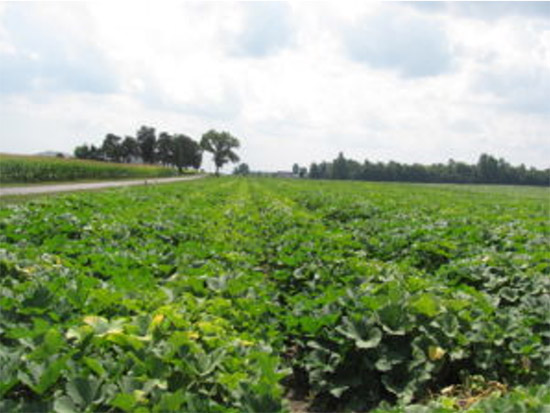
Figure 1. The yellowing of these pumpkin leaves seems to run down the row.
Look again at figure 1 to try out which part of the leaves are yellow. For the most part, the portion of the leaves that are yellow are the edges (or margins) of the leaves (Figure 2). One doesn't see entire leaves that are yellow. The yellowing doesn't appear in the interior of the leaves. Yellowing on the outside of the leaf normally means that the reason is stress related as discussed above.
Older leaves tend to become yellow with time because nutrients like nitrogen are mobile in the plant and will move to the younger leaves where they are needed. In addition, the edges of leaves may become yellow because the edges of leaves have pores where sap (known as the water of guttation by botanists) is secreted at night. This sap may have a mildly toxic effect on the leaves over time—this is the reason that the edge of older leaves may become yellow.
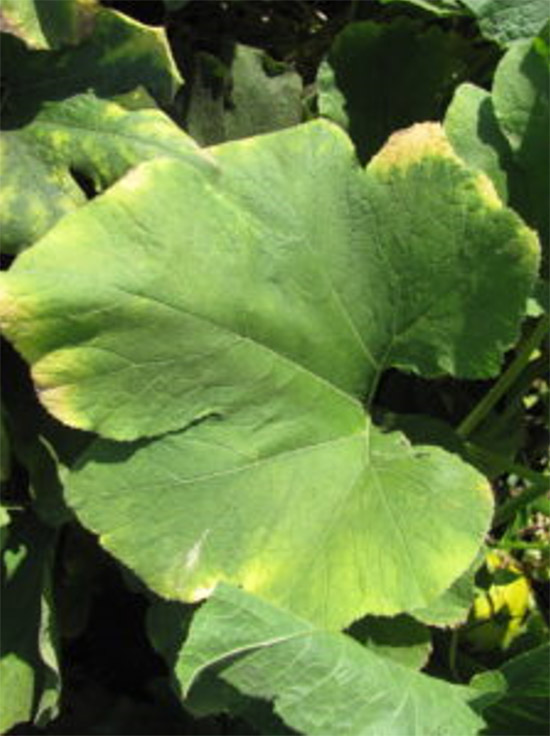
Figure 2. The edges of this pumpkin leaf are yellow, most likely due to environmental stress.
In figure 3, the yellowing of the pumpkin leaves is more generally over a larger area in contrast to figure 1 where the yellowing could be seen to run down a row. Most of the yellowing appears in the foreground of the photo in figure 3. If one looks down the hill, the leaves appear green and healthy. Now, let's look at the soil next to the symptomatic pumpkin leaves. The soil appears sandy.
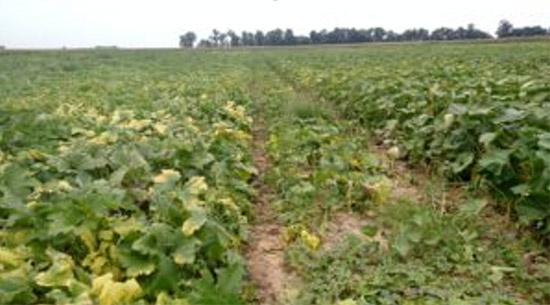
Figure 3. This view is from the top of the hill looking down. The pumpkin plants in the foreground of this photos have yellow leaves. The soil is sandy at the top of the hill.
Next, we will walk down the hill where the pumpkin leaves are green and look back up toward the yellowed pumpkin leaves (Figure 4). Again, we notice that the area on top of the hill are in a general area—they don't seem to run down a row. That is, it isn't just the older leaves that are yellow. Now, take a look at the soil next to the green pumpkin leaves at the bottom of the hill. The soil is much heavier with more of a clay content than the soil at the top of the hill.
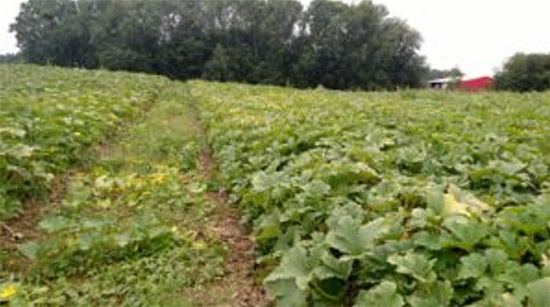
Figure 4. This view is from the bottom of the hill looking up. The pumpkin leaves at the bottom of the hill are generally green and healthy. The soil at the bottom of the hill is relatively heavy.
The lesson here is that the pumpkins at the top of the hill had much less access to water than the bottom of the hill. This is true both because hills tend to be better drained and because sandier soils hold less water. The grower had drip irrigation in place, but was not able to pump much water due to lack of water in a surface pond. Therefore, the yellowing leaves at the top of the hill is due to drought stress.
Both of the fields of pumpkins pictured here produced good crops. The yellow on the pumpkin leaves does not necessarily indicate a disaster or a disease is in the future.
I hope the photos and discussion presented here will help one to figure out what is wrong in one's pumpkin patch. However, if one still has questions about symptoms, it is best to send off a sample to a diagnostic laboratory.
Dan Egel, Extension Plant Pathologist, Purdue Vegetable Crops Hotline, Purdue University (812-886-0198; egel@purdue.edu)
Managing Voles in Fruit and Vegetable Plantings
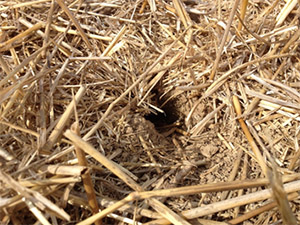
Vole burrow in a double crop pumpkin
field. Photo: N Johanning.
With the rapid approach of fall, damage from various mammal pests can increase, as easily available food sources become less abundant. Voles can become problematic in a number of different plantings, including but not limited to orchards, blueberries, pumpkins, and plasticulture strawberries. With pumpkin season in full swing and strawberry plug plants being set by mid-September, growers need to remember to monitor for vole activity and be ready with control options. The field environment created by strawberry plasticulture production is particularly inviting to voles so monitoring for vole activity should be part of your weekly scouting routine. If voles are present in your field, achieving a level of control prior to applying row covers is strongly suggested.
There are three different species of voles; prairie, pine, and meadow; that can be problematic, and correct identification is key in deciding which control measures need to be followed. University of Missouri Extension has an excellent publication, Controlling Voles in Horticulture Plantings and Orchards in Missourithat provides information on vole species' characteristics, trapping, monitoring, and control options. Another source for vole management options in orchards and small fruit planting is the 2017 Midwest Fruit Pest Management Guide, pages 72-74.
Bronwyn Aly (618-382-2662; baly@illinois.edu)
Less Seriously...
Looking through some archived David Letterman Top Ten lists. This one is obviously dated but a reminder of why our customers appreciate Know Your Farmer, Know Your Food. http://www.mudslide.net/TopTen/lnwdxtra.html#extra11
Top 10 Fears of McDonald's Managers
10. Under excruciating torture, I might reveal the ingredients of secret sauce
9. Customers will figure out fish sandwich and apple pie are exact same item
8. Mayor McCheese's nude, lifeless body will be found in a cheap hotel room
somewhere down south
7. Might someday accidentally eat a McNugget
6. After sex with wife, might mistakenly say, "Do you want fries with that?"
5. One of the trainees wants to man the shake machine and damn it - he's
not ready!
4. Something will happen to Bush
3. Even after selling a billion Big Macs, I'll still feel kind of empty inside
2. Someday a race of super cows will make paper-thin burgers out of me
1. That might not be mayonnaise
University of Illinois Extension Specialists in Fruit and Vegetable Production & Pest Management
Extension Educators – Local Food Systems and Small Farms |
||
Bronwyn Aly, Gallatin, Hamilton, Hardin, Pope, Saline, and White counties |
618-382-2662 |
|
Katie Bell, Franklin, Jackson, Perry, Randolph, & Williamson counties |
618-687-1727 |
|
Sarah Farley, Lake & McHenry counties |
847-223-8627 |
|
Nick Frillman, Woodford, Livingston, & McLean counties |
309-663-8306 |
|
Laurie George, Bond, Clinton, Jefferson, Marion, & Washington counties |
618-548-1446 |
|
Zachary Grant, Cook County | 708-679-6889 | |
Doug Gucker, DeWitt, Macon, and Piatt counties |
217-877-6042 |
|
Erin Harper, Champaign, Ford, Iroquois, and Vermillion counties |
217-333-7672 |
|
Grace Margherio, Jackie Joyner-Kersee Center, St. Clair County |
217-244-3547 |
|
Grant McCarty, Jo Daviess, Stephenson, and Winnebago counties |
815-235-4125 |
|
Katie Parker, Adams, Brown, Hancock, Pike and Schuyler counties |
217-223-8380 |
|
Kathryn Pereira, Cook County |
773-233-2900 |
|
James Theuri, Grundy, Kankakee, and Will counties |
815-933-8337 |
|
Extension Educators – Horticulture |
||
Chris Enroth, Henderson, Knox, McDonough, and Warren counties |
309-837-3939 |
|
Richard Hentschel, DuPage, Kane, and Kendall counties |
630-584-6166 |
|
Andrew Holsinger, Christian, Jersey, Macoupin, & Montgomery counties |
217-532-3941 |
|
Extension Educators - Commercial Agriculture |
||
Elizabeth Wahle, Fruit & Vegetable Production |
618-344-4230 |
|
Nathan Johanning, Madison, Monroe & St. Clair counties |
618-939-3434 |
|
Campus-based Extension Specialists |
||
Kacie Athey, Entomology |
217-244-9916 |
|
Mohammad Babadoost, Plant Pathology |
217-333-1523 |
|